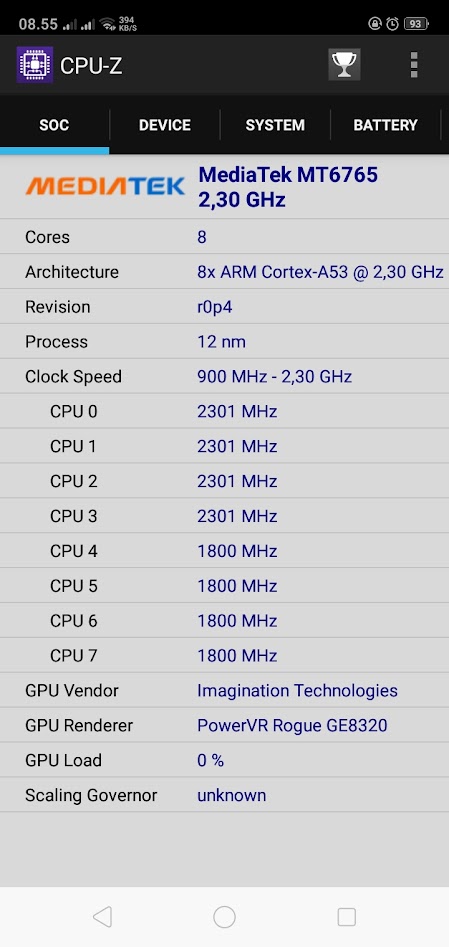Comparing: Intel Core i7 7700K vs MediaTek MT6765 Helio P35
In this comparison, we analyze two Processors: Intel Core i7 7700K and MediaTek MT6765 Helio P35, using synthetic benchmark tests to evaluate their overall performance. This side-by-side comparison helps users understand which hardware delivers better value, speed, and efficiency based on standardized testing. Whether you're building a new system or upgrading an existing one, this benchmark-driven evaluation offers valuable insights to guide your decision.

MediaTek MT6765 Helio P35
| Type: | Processors |
|---|---|
| Brand: | MediaTek |
| Model: | MediaTek MT6765 |
Specification Comparison Table
This specification comparison presents technical details of several devices or components to help you understand the key differences between each option. Use this table as a reference to determine which device best suits your needs.
| Specification | Intel Core i7 7700K | MediaTek MT6765 Helio P35 |
|---|---|---|
| Architecture | x86 | ARM |
| Technology | 14 nm | 12 nm |
| Clock | 4.2 GHz - 4.5 GHz | 1.8 GHz - 2.3 GHz |
| Core/Thread | 4 / 8 | 8 / 8 |
| Segmen | Desktop | Mobile |
Submission Comparison Table
This submission comparison table displays the number and details of benchmark data submissions from various devices or components. This information helps you understand the performance based on the benchmarks that have been tested, as well as providing an overview of the consistency and popularity of the available benchmark results.
Submission Comparison Chart
This chart visualizes the benchmark scores comparison between two hardware devices based on submitted data.
Media Gallery
A collection of photos of tested hardware. These images can help you identify the physical form, model, and variant of the hardware in question. These photos are from our own documentation, and if they are not available we may not be able to document them.
About Hardware Intel Core i7 7700K
The Intel Core i7-7700K, launched in early 2017, is a high-performance desktop processor from the 7th generation Kaby Lake family. Built on the 14nm process, the i7-7700K features 4 physical cores and 8 threads, thanks to Hyper-Threading Technology, and is targeted at enthusiasts, gamers, and power users. It operates at a base frequency of 4.2 GHz and can boost up to 4.5 GHz via Intel Turbo Boost, delivering excellent single-threaded performance one of the highest at the time of its release.
As part of Intel’s “K” series, the Core i7-7700K has an unlocked multiplier, making it ideal for overclocking on compatible Z-series motherboards. However, with a TDP of 91W, the processor demands an effective cooling solution, especially when overclocked beyond its stock speeds. Users typically pair this CPU with aftermarket air or liquid coolers to ensure thermal stability under heavy workloads or gaming sessions.
The processor includes Intel HD Graphics 630, which supports 4K output at 60Hz and is sufficient for basic tasks like web browsing, video playback, and office work. However, for serious gaming or GPU-accelerated workloads, a discrete graphics card is still necessary, especially when paired with a high-refresh-rate monitor or demanding software.
In terms of real-world performance, the i7-7700K remains capable even today for 1080p and 1440p gaming, general productivity, and creative tasks. It delivers solid frame rates in many modern titles when used with a modern GPU, and it handles applications like Adobe Photoshop, Premiere Pro, and coding environments reasonably well. However, due to its limited core count by today’s standards and lack of PCIe 4.0 support, it has started to show its age in multi-threaded and next-gen workloads.
Despite being surpassed by newer Intel and AMD CPUs with more cores and better efficiency, the i7-7700K still holds value in many mid-range desktop setups, especially for users who already own an LGA 1151 system and want to maximize performance without a full platform upgrade.
Thursday, 23 June 2022 07:42:37 | Update: 1 month ago
About Hardware MediaTek MT6765 Helio P35
The MediaTek Helio P35 (MT6765) is a mid-range mobile processor introduced in 2018, designed to offer a balance between performance, efficiency, and affordability. It features eight ARM Cortex-A53 cores, all running at speeds of up to 2.3 GHz, allowing for decent multitasking and responsiveness in everyday applications.
Built using the more efficient 12nm fabrication process, the Helio P35 is a significant improvement over older chips like the MT6750 or MT6737, both in terms of power consumption and thermal performance. This makes it well-suited for entry-level and mid-range smartphones with tighter thermal and battery constraints.
For graphics, the SoC integrates the PowerVR GE8320 GPU, which supports Full HD+ displays and provides enough power for media consumption and light gaming. It also includes support for AI-enhanced features, such as image processing and face detection, though without a dedicated NPU, the AI performance is modest compared to higher-tier chipsets.
While the Helio P35 is not intended for high-performance gaming, it performs well for tasks like social media, video playback, camera use, and general app usage. However, more demanding 3D games will run only at low graphics settings with occasional frame drops.
Hardware Detail:
Devices: OPPO A5s & OPPO A15s.
Device Specifications: MediaTek MT6765, 3/32 (A5s), 4/64 (A15s), Android 8 (A5s), Android 10 (A15s).
Room Temperature: 30°C based on DHT11 Sensor.
* Note: The OPPO A15s was used in some tests due to compatibility issues with Android 8 on A5s in certain applications.
Sunday, 08 September 2019 11:02:46 | Update: 1 month ago



